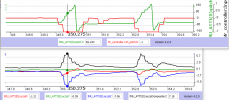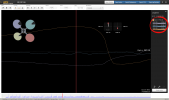You are using an out of date browser. It may not display this or other websites correctly.
You should upgrade or use an alternative browser.
You should upgrade or use an alternative browser.
How many Gs does the DJI FPV drone experience?
- Thread starter Dangerly
- Start date
It all depends on a combination of the smallest turn radius & the highest speed you can keep through out it, considering air slip and a perfect banking for the circumstances.
The highest G force it can achieve ought to be the braking force when going max 140km/h straight into a solid object.
If the deacceleration time is somewhere near a half of a second... that would generate close to 8G... and we know what happens to a DJI FPV Drone then
The highest G force it can achieve ought to be the braking force when going max 140km/h straight into a solid object.
If the deacceleration time is somewhere near a half of a second... that would generate close to 8G... and we know what happens to a DJI FPV Drone then
An easier solution is just to post a log file. Those have all the necessary data to calculate 3-axis acceleration.
db4476
Well-Known Member
Interesting, I really never gave much thought about G's in regard to flying a drone.An easier solution is just to post a log file. Those have all the necessary data to calculate 3-axis acceleration.
As @sar104 pointed out, you can calculate with the data from the log very simply.
If the accelerometer data is reported in SI unit, (meters/second squared) just divide by 9.81 for G's.
For directionless G measurement in code: double g = sqrt(x * x + y * y + z * z)
Cheers!
The txt logs don't include the raw accelerometer data - only the fusion velocities. But it is trivial to differentiate those with respect to time to calculate accelerations.Interesting, I really never gave much thought about G's in regard to flying a drone.
As @sar104 pointed out, you can calculate with the data from the log very simply.
If the accelerometer data is reported in SI unit, (meters/second squared) just divide by 9.81 for G's.
For directionless G measurement in code: double g = sqrt(x * x + y * y + z * z)
Cheers!
I managed to pull 7.18 Gs by starting with full throttle in level flight. Then a loop with full back pitch. The max acceleration occurred when the FPV passed through 70° on the first loop and 40° on the second loop.Has anyone attached a g-meter to the DJI FPV to see how many Gs it pulls in the most intense direction changes? If no one has done that test, I'm thinking I might do that.
Or, is this information available (maybe indirectly after some calculations) in the logs somewhere?

I know the thread was regarding the FPV drone ... but when I saw what you clocked trying to max it @BudWalker ... I went through the Blackbox from one of my fastest quads, just to see what I could find.I managed to pull 7.18 Gs...
This was from a ordinary freestyle flight ... so nothing about trying to maximize any G's ...
Definitely highest in the Z-axis when doing short punch ups to get some ascending momentum before flips, highest here was 6.28 G

Similar threads
- Replies
- 19
- Views
- 4K
- Replies
- 23
- Views
- 18K
- Replies
- 1
- Views
- 659
- Replies
- 7
- Views
- 2K
DJI Drone Deals
New Threads
-
-
-
-
-
Request: DJI Mavic Enterprise 3T: Fixed Thermal Palette Scaling (Consistent Colors Across Images & Video)
- Started by hanspeter.liniger01@gmail
- Replies: 1
Members online
Total: 2,630 (members: 13, guests: 2,617)










